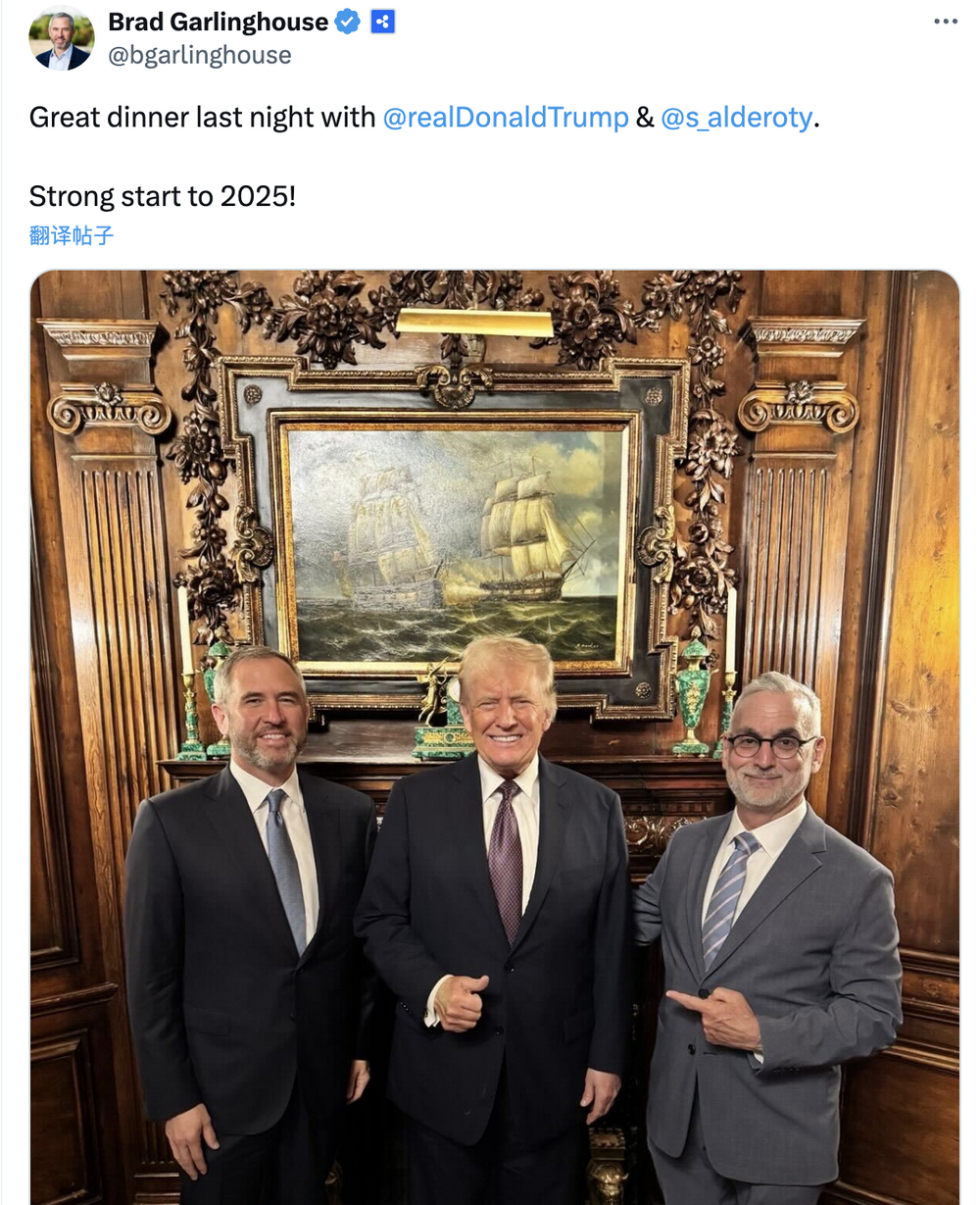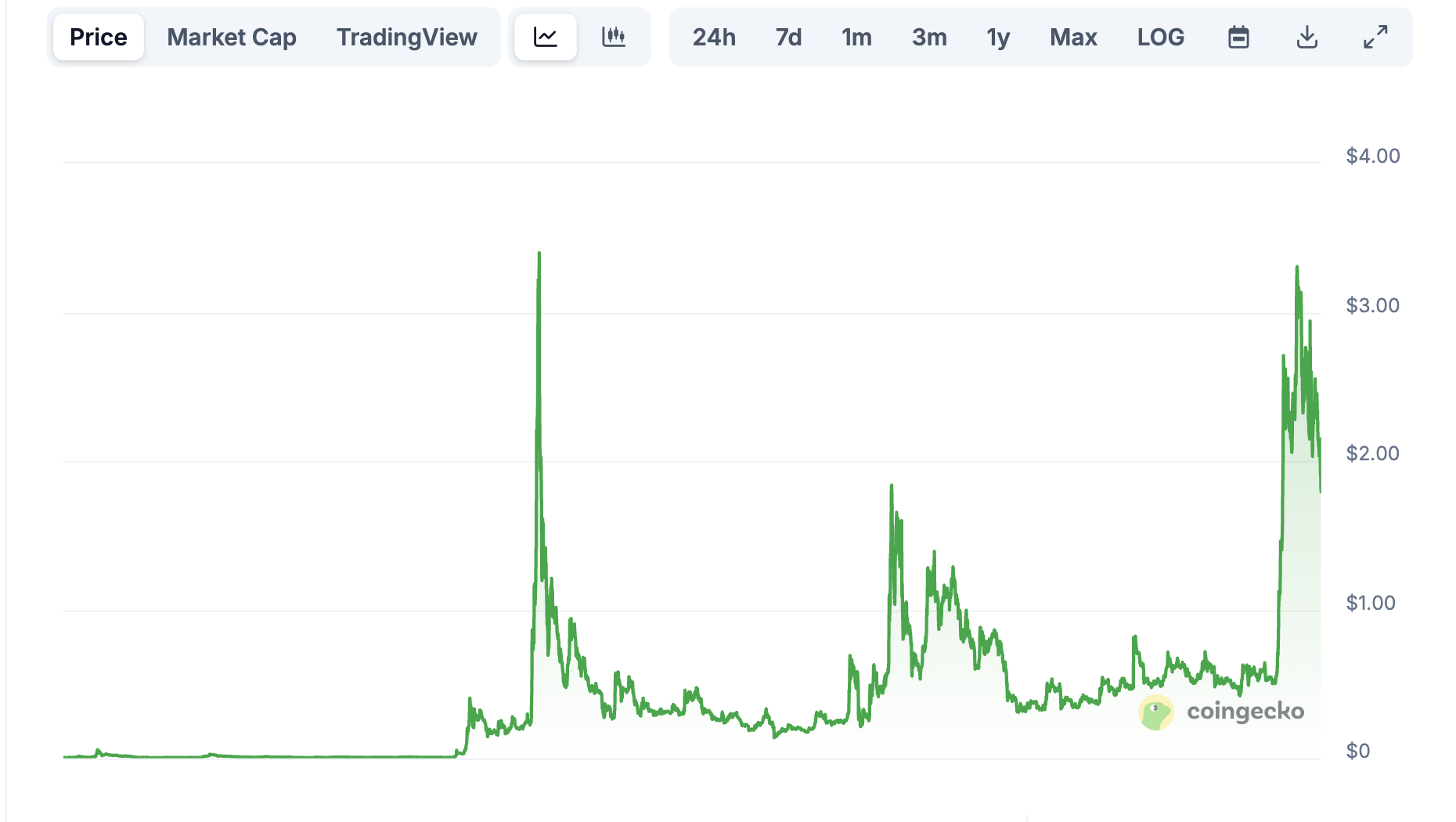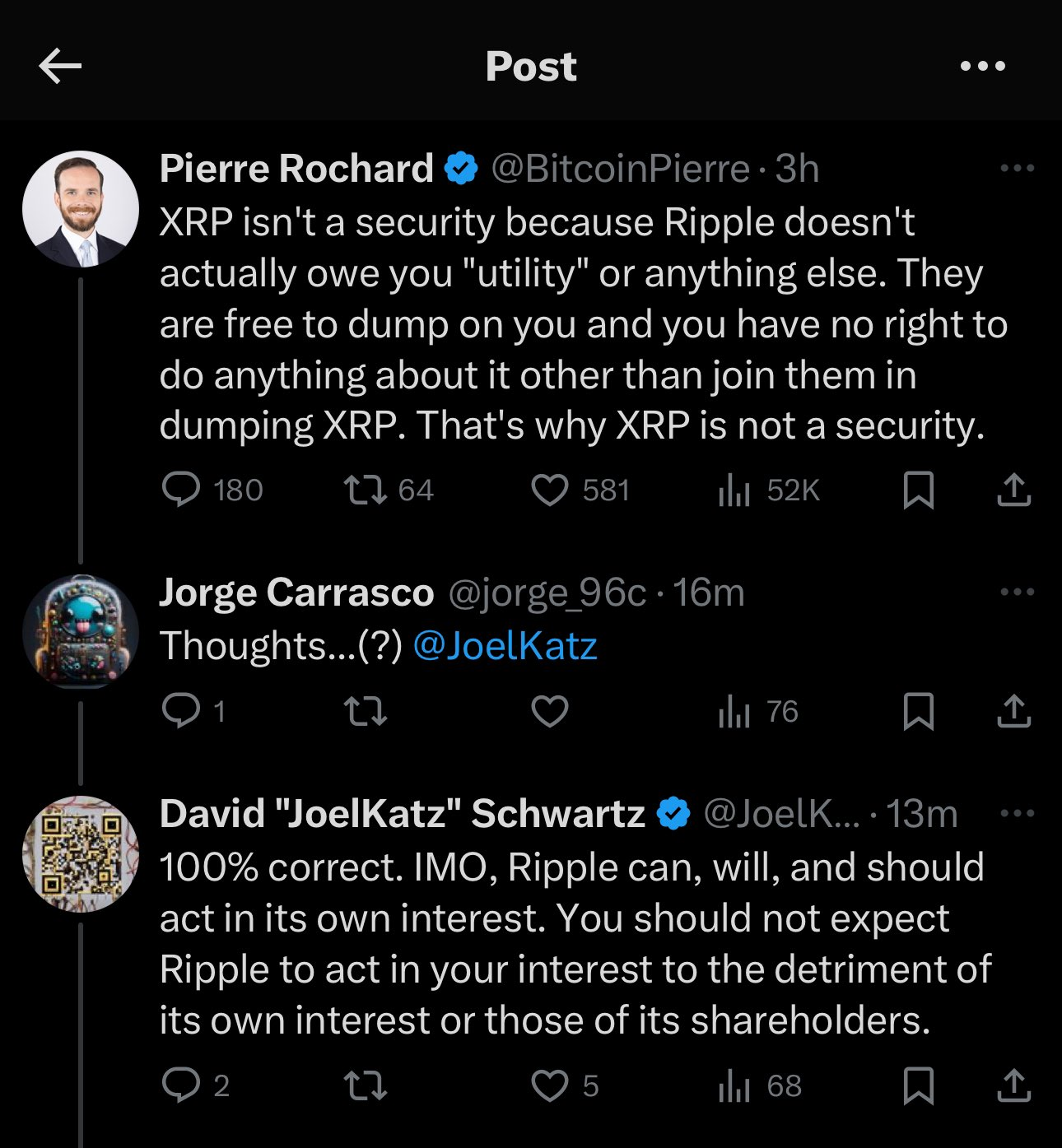Author: Nancy, PANews
Decentralization is regarded as the core tenet of the crypto world; however, the story of the long-established public chain Ripple is filled with drama and contrast. Since its inception, Ripple has been controversial due to its highly centralized token distribution model, criticized for deviating from the spirit of cryptocurrency, with even its founder admitting that the company "relies on selling tokens for survival." Meanwhile, this crypto project with a market value of hundreds of billions of dollars has been accused of lacking technological innovation and showing mediocre revenue performance, with Forbes unflinchingly labeling Ripple as a "zombie company."
Despite this, the market and reality tell a different story. Ripple has won the favor of financial institutions, and its market value often experiences explosive growth, even rivaling traditional giants. Recently, multiple factors such as rising ETF expectations, support from U.S. political forces, advancements in payment services, and significant investments in stablecoins have once again brought Ripple into the spotlight.
Focusing on Payments, Ripple Expands Across Multiple Lines of Business
Ripple has continued to push for business expansion this year. As is well known, cross-border payment remittances are Ripple's core business, and this year it has continued to extend its reach globally. For instance, Ripple has expanded its African business landscape through a partnership with Chipper Cash, collaborated with Portugal's oldest currency exchange Unicâmbio to promote instant payments between Brazil and Portugal, and SBI New Bank has adopted Ripple's DLT for international remittances.
To ensure the continuous legal and compliant operation of its business, Ripple is vigorously advancing its global licensing application efforts. As of April 2025, Ripple has obtained over 55 remittance licenses (MTL) worldwide, covering 33 states in the U.S. and locations like Dubai. In just the past few months, Ripple has secured remittance licenses in New York and Texas and has become the first blockchain payment provider to obtain a payment license from the Dubai Financial Services Authority, allowing it to offer regulated cryptocurrency payment services in the UAE.
Moreover, Ripple is further expanding its influence in the payment sector through the stablecoin RLUSD. Since its launch in December last year, the market capitalization of RLUSD has risen to over $290 million. This year, Ripple has accelerated the expansion of RLUSD's application scenarios. For example, Ripple has partnered with Chainlink to enhance RLUSD's utility in the DeFi space; collaborated with Revolut and Zero Hash to broaden RLUSD's market coverage; and recently, RLUSD was listed on the exchange Kraken and integrated into Ripple Payments, its payment solution, for cross-border payment processes for clients like BKK Forex and iSend. In the future, Ripple plans to open up RLUSD's usage rights to more payment platforms.
Recently, Ripple announced a $1.25 billion acquisition of the cryptocurrency-friendly prime broker Hidden Road, marking one of the largest acquisition deals in the cryptocurrency industry to date. As a major brokerage and credit network, Hidden Road has over 300 institutional clients and has cleared more than $10 billion through traditional payment channels, processing over 50 million transactions. After this acquisition is completed, Hidden Road will integrate RLUSD as collateral for its main brokerage products and migrate its post-trade activities to the XRPLedger blockchain. This will not only bring more liquidity and application scenarios to RLUSD but also help Ripple further strengthen its position in the real-world asset (RWA) sector.
Additionally, Ripple is expanding its crypto custody and wallet services. In mid-March this year, Ripple Labs submitted a trademark application for "Ripple Custody." According to the application documents, the trademark covers financial services, including the storage and management of crypto assets to meet financial management needs. This trademark application follows Ripple's launch of custody services in October 2024 and may indicate that the company is seeking to diversify its revenue sources beyond payment settlements. The trademark application also mentions "downloadable software for the custody, transfer, and storage of cryptocurrencies, fiat currencies, virtual currencies, and digital currencies," which may suggest that Ripple is considering launching an official crypto wallet. If this product comes to fruition, it could create new revenue growth points through transaction fees.
Notably, Ripple CEO Brad Garlinghouse recently revealed that Ripple plans to venture into financial sectors such as payments, real estate, and securities trading in the future.
SEC Withdraws Lawsuit, Winning Four-Year Litigation, "Close" Relationship with Trump
With Trump's rise to power, the regulatory environment for the U.S. crypto industry has clearly shifted towards a more lenient stance, and Ripple, which has experienced years of ups and downs, has also achieved a "significant victory." In March this year, Ripple announced that the U.S. SEC had officially withdrawn its four-year lawsuit against the company, and both parties reached a preliminary settlement agreement, with the SEC agreeing to return $75 million of the $125 million fine imposed by the court last year, retaining only $50 million to close the case. In exchange, Ripple will withdraw its cross-appeal.
"This moment has finally arrived, the moment we have long awaited. The SEC will drop the appeal; this is a complete victory for Ripple, and from any perspective, it is a victory for the crypto industry. The future is bright. Let's build together," Garlinghouse announced in a post at that time.
Prior to this, Ripple's expansion in the U.S. market had been severely hampered due to the prolonged "securities dispute" with the SEC. Garlinghouse revealed in an exclusive interview with Fox Business that the SEC's lawsuit forced Ripple to shift 95% of its customer base to overseas markets. To address this predicament, Ripple actively engaged in U.S. political lobbying and invested heavily in the super PAC Fairshake during the 2024 U.S. election, becoming one of the most generous corporate donors in the crypto industry.

Ripple's "close relationship" with Trump has also injected imaginative space into its expansion in the U.S. In early January this year, Garlinghouse shared a photo on X of a dinner with Trump and others at Mar-a-Lago, which attracted widespread attention. Shortly thereafter, during the initial issuance of Trump's MEME coin TRUMP, Ripple and Galaxy Digital provided a $160 million emergency loan to the crypto payment company MoonPay to ensure that its high trading demand during the initial launch could be met. This support is believed to have played a significant role in the early rapid growth of the TRUMP token.
In mid-February, Trump shared an article about XRP on Truth Social, quoting Garlinghouse's statement that since Trump won the election last November, the company's business transactions and hiring in the U.S. have significantly increased. This move quickly ignited market sentiment, leading to a surge in XRP trading volume. Last month, Trump further announced that XRP and other cryptocurrencies would be included in the U.S. strategic reserve, a policy declaration that sparked enthusiastic market reactions.
Accelerating Global Layout of XRP ETF, CEO Says It May Launch in the Second Half of the Year
As the regulatory environment for cryptocurrencies in the U.S. rapidly evolves, the surge in ETF applications has also provided significant momentum for Ripple.
Since the beginning of this year, there have been frequent developments regarding XRP ETF products. For example, the asset management company Purpose Investments submitted a preliminary prospectus for the first Ripple ETF to Canadian securities regulators; in February, Brazil approved the world's first spot XRP ETF, which will be listed on the B3 exchange in Brazil; in March, Hashdex submitted an amendment to the U.S. SEC, planning to expand its ETF product to include cryptocurrencies like XRP; and recently, Teucrium Investment Advisors launched the first leveraged ETF linked to XRP in the U.S., aiming to provide double daily returns on XRP tokens.
At the same time, several well-known institutions, including Bitwise, Grayscale, WisdomTree, and Franklin Templeton, have also submitted applications for spot XRP ETFs, but these applications have yet to receive SEC approval. However, Nate Geraci, president of The ETF Store, believes that the end of the Ripple-SEC lawsuit means that the approval of a spot XRP ETF is "clearly just a matter of time." Bloomberg analyst James Seyffart shares a similar view, predicting that the XRP ETF may launch in the coming months, and it is likely that ETF products based on XRP futures will be seen first.
Garlinghouse revealed in an interview with Bloomberg TV that the XRP ETF may launch in the second half of 2025, and there are currently about 11 different companies' XRP ETF issuance applications awaiting approval from the U.S. SEC. Additionally, he mentioned that an IPO for Ripple Labs is not out of the question.
Token Price Hits Multi-Year High, Token Model Sparks Controversy
Driven by multiple favorable factors, the price of XRP has seen a significant boost. According to CoinGecko data, since the beginning of this year, XRP has risen by as much as 70.62% to $3.30, reaching a new high not seen since January 2018.

Garlinghouse has stated that with the rise in XRP's price and the growing demand for Ripple's blockchain solutions, the company's previous valuation of $11 billion is now "seriously outdated."
Standard Chartered recently released a report stating that XRP increased sixfold within six months after Trump's election. This growth is sustainable, partly due to changes in the SEC's leadership and because XRP uniquely occupies one of the most promising application areas for digital assets—cross-border and cross-currency payments. At the same time, the XRP Ledger (XRPL) aligns closely with the primary use cases of stablecoins (such as Tether), which support financial transactions completed by traditional financial (TradFi) institutions through blockchain technology. It is predicted that stablecoin transaction volumes will grow tenfold in the next four years. Ripple also plans to expand XRPL into the tokenization field, and these positive factors suggest that XRP should be able to keep pace with its biggest competitor, Bitcoin. The institution expects that before Trump leaves office, XRP could rise to $12.50. However, Standard Chartered also supports that XRPL faces two drawbacks: a limited number of developers and its limited value capture capability.

However, Ripple's token model has also sparked controversy. For instance, Pierre Rochard, Vice President of Research at Riot Platforms, warned that investors "are not investing in Ripple the company, but merely acquiring tokens that are created out of thin air. XRP is not a security because Ripple does not actually owe you 'utility' or anything else." In response, Ripple's Chief Technology Officer David "JoelKatz" Schwartz stated, "Ripple can, will, and should act in its own interests. Investors should not expect Ripple to profit investors at the expense of the company and its shareholders." This statement implies that Ripple has the right to sell XRP tokens to raise operational funds, raising concerns among investors. In fact, Garlinghouse has also admitted, "If we do not sell our XRP assets, we will not be profitable or generate positive cash flow."
Public information shows that the total issuance of XRP is 100 billion tokens, of which 20 billion are owned by the three founders Chris Larsen, Jed McCaleb, and Arthur Britto, while the remaining 80 billion are allocated to Ripple Labs.
To alleviate market concerns about XRP supply, Ripple has locked 55 billion XRP (55% of the total) in custodial accounts based on the XRP Ledger since 2017. These custodial accounts are controlled by smart contracts, automatically unlocking 1 billion XRP each month, which was adjusted to 450 million per month after 2020. However, not all unlocked tokens enter market circulation; Ripple typically only uses a portion of the unlocked tokens (such as 20%-25% for market sales), while the remaining portion is re-locked in custody for release in future months.
It is worth noting that Ripple's founders still hold a significant amount of XRP. According to crypto detective ZachXBT, as of March, the XRP address activated by Ripple co-founder Chris Larsen still holds over 2.7 billion XRP (approximately $7.18 billion). These addresses related to Larsen transferred XRP worth over $109 million to exchanges in January 2025.
免责声明:本文章仅代表作者个人观点,不代表本平台的立场和观点。本文章仅供信息分享,不构成对任何人的任何投资建议。用户与作者之间的任何争议,与本平台无关。如网页中刊载的文章或图片涉及侵权,请提供相关的权利证明和身份证明发送邮件到support@aicoin.com,本平台相关工作人员将会进行核查。




